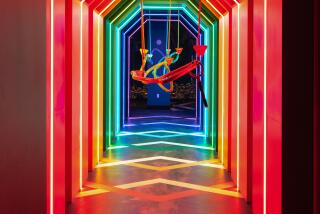In animated ‘Logorama,’ brand names rule
- Share via
The Paris-based design company H5 has built its reputation primarily on commercials and music videos. In the U.S., its best-known work includes innovative videos for Massive Attack and Röyksopp as well as the hard-to-get-out-of-your-head commercials for Areva, the French energy conglomerate. The company has even shown some of its work at museums, including the Centre Pompidou and the Museum of Modern Art in New York.
Now it’s Hollywood’s turn to discover one of the design world’s best-kept secrets.
“Logorama,” a 16-minute computer-animated film developed by H5, is nominated for an Academy Award in the category of animated shorts. The movie depicts a chaotic, alt-universe L.A. where people, vehicles and buildings are all represented by brand logos.
The principal characters in “Logorama” include a gun-wielding Ronald McDonald, a pair of wisecracking Michelin Men, a sexy Esso girl and two Mr. Pringle’s -- “original” and “hot & spicy” flavors.
“Logorama” name-checks a host of other global brands: Microsoft, Evian, Best Western, EMI, Domino’s Pizza, Avis, Pioneer, Blockbuster Video and much more.
At its most obvious level, the film’s infinite brandscape serves as a dystopian critique of mindless, American-style consumer culture -- as well as an nth-degree joke about movie product placement.
At the same time, the filmmakers -- François Alaux, Hervé de Crécy and Ludovic Houplain -- have clearly been inspired by the culture-jamming axiom known as détournement, a Situationist-derived practice that involves the subversion of cultural symbols by using them against themselves.
In “Logorama,” Mr. Clean sheds his hyper-masculine image to become a lisping, mincing muscle queen. In another scene, the MGM lion’s ferocious roar is reduced to a fatigued whimper.
Guy Debord, the Situationist philosopher, famously wrote that “in societies where modern conditions of production prevail, all of life presents itself as an immense accumulation of spectacles. Everything that was directly lived has moved away into a representation.”
“Logorama” creates a vast, hypnotic world where Debord’s proclamation has become a reality.
- David Ng
More to Read
The biggest entertainment stories
Get our big stories about Hollywood, film, television, music, arts, culture and more right in your inbox as soon as they publish.
You may occasionally receive promotional content from the Los Angeles Times.










